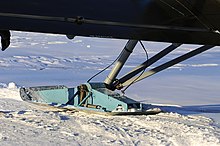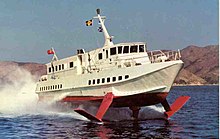Skid
A runner is an elongated, spar-like element with a straight, smooth undersurface as a load-bearing part of a construction, namely below an object. A load-bearing, connecting frame is installed on them , on which the entire weight of the load (e.g. a vehicle, passengers) rests in many designs. The inclination of the front tip upwards is characteristic of runners. This ensures that the weight does not sink onto the driving surface (snow, water).
Origin and construction
The concept of the runner is a longer beam with an upwardly curved front end. The word 'Kufe' itself is related to cooperage , the cooperage , actually the production of curved staves (see Küfe ). It is only recorded in Upper German (östrr. Khueffe , bair. Kueffen ), but probably of very old origin.
On the one hand, the runner should be a further development of the loop , i.e. a towing platform. The relationship of the word 'Kufe' to an Old Norse kjalki m. (for example: Danish kjelke , Swedish kälke ) in the original meaning pine , jaw cheek suggests that the original construction principle - at least as far as the use on snow and ice is concerned - could be the adoption of whale pines, corresponding to the early bone ice skates . Constructions of historical sleighs also show that the platform of the loop can be understood as being jacked up on the runner. In contrast to the loop, the runner offers a certain guidance (track), which makes the vehicle easier to control and also allows faster movement.
There are different concepts, that of the resilient, wide sliding surface for soft forms of snow and mud, analogous to the ski or the toboggan , and a sharp-edged sliding edge for bare ice, such as on ice skates or racing bobsleighs and skeleton , and that of the rounded ones , which are also on earth or used on sandy ground.
In terms of construction history, the runner develops like the wheel , and also shows a similar structure: the actual runner as an unrolled wheel rim , struts ('feet') instead of spokes, similar construction process and materials, iron fittings analogous to wheel tires . Today there are variations in the material (wood, metals, plastics), in the reinforcement (mostly metal fittings), and numerous specialized designs in length, width, profile, and also different numbers on the vehicle.
A few runners are steerable , e.g. B. in historical double-frame heavy wooden pulling sleds or modern snowmobiles . The two-skid pulling slide can be steered - to a limited extent - by bending the two long, extended skid arches, as is the luge that has emerged from it .
Function and use
Runners are used to slide, slide, put on or rock . They are mainly used in means of transport (vehicles and sports equipment). The most common use of skids is for locomotion on land or in water.
Locomotion
Runners that are used for locomotion provide guidance due to their generally small width compared to their greater length. The bars are bent forward like a ski tip . Among other things, this compensates for minor bumps in the runner. It is also used for safety, as otherwise there would be an abrupt stop or a fall ( tracked vehicles also use this principle ). They are used for locomotion on land when wheels cannot be used. This applies to a soft surface, such as B. snow, or smooth surfaces such. B. ice, but also sand, too.
Skids, which are used for locomotion, ideally lie flat on the ground and are usually arranged in pairs and parallel. The longer a runner is, the more unevenness in the subsurface is leveled out. Runners are available on almost every ice skate and sledge (load carrier or sports equipment). Some ice skates have a jagged end part at the sloping end of the runner, with which the ride can be decelerated (braked). When ice surfing , the runners under the board are used for surfing.
Cylindrical vacuum cleaners from the 1960s stood on runners made of chrome-plated tubular steel with round Bakelite end caps.
Also Eisbobs and Skeletons have runners, even the latter (also with using screws adjustable longitudinal profile jump called). The material, shape and treatment of the runners before the ride are strictly regulated. Also akias , sledges and the simplest ski-doos in front for steering.
Means of transport (vehicles)
Skids are an essential element of the land vehicle type of skid vehicle .
On hydrofoils there are at least two runners (called wings) that are located under the bow. Steel runners are installed here that have to resist the water pressure. You therefore have an acute angle of attack to the direction of travel. They only take effect when driving fast ( gliding ). About a third of the ship lifts out of the water and experiences a change in its longitudinal axis . This saves energy because part of the underwater hull does not have to be “pushed” through the water. Snowmobiles consist of a combination of runners (front) and a caterpillar-like drive (rear).
Although skis do not have runners, they are also runners when combined with a body, so these structures have a steerable ski at the front and two rigid skis at the rear. The driver sits on the small structure. Different types of skis have a central groove on the back 3/4 of their length, skis for ski jumping even several, which improve the tracking and thus act similar to skid tracks. Skiing on skibobs or one-legged (handicapped) skiing with support poles with short ski runners can be seen as 3-runners skiing.
Aircraft



Fixed-wing aircraft that land on the snow are often equipped with ski runners . Some helicopters have two parallel, lengthways and mostly over the length of the vehicle to touch down under the fuselage . These runners, which are of several types, are called landing devices . It can be used on soft ground, such as sand, or on the water.
The Transrapid has runners that rest on the roadway when the vehicle is stationary and that allow it to slip and thus reduce its speed to a standstill even in the event of a fault occurring while driving.
Seesaws
Skids used for rocking are curved in a circle. They are common in seating furniture and large toys (examples: rocking chair and rocking horse ). Without additional energy supply, they can only bob briefly due to friction losses.
literature
- Joachim Köninger: Loop, sledge, wheel and wagon: on the question of early means of transport north of the Alps . Janus, 2002 (round table Hemmenhofen October 10, 2001).
Individual evidence
- ↑ Entry KUFE, f. sled runner u. Ä. In: Jacob Grimm, Wilhelm Grimm: German dictionary . Leipzig 1854–1960 (dwb.uni-trier.de)
- ↑ a b See for example: Loops and sledges. (No longer available online.) In: Farming through the ages. Agricultural Museum Schloss Ehrental, archived from the original on April 15, 2006 ; Retrieved November 7, 2008 . Info: The archive link was inserted automatically and has not yet been checked. Please check the original and archive link according to the instructions and then remove this notice.



